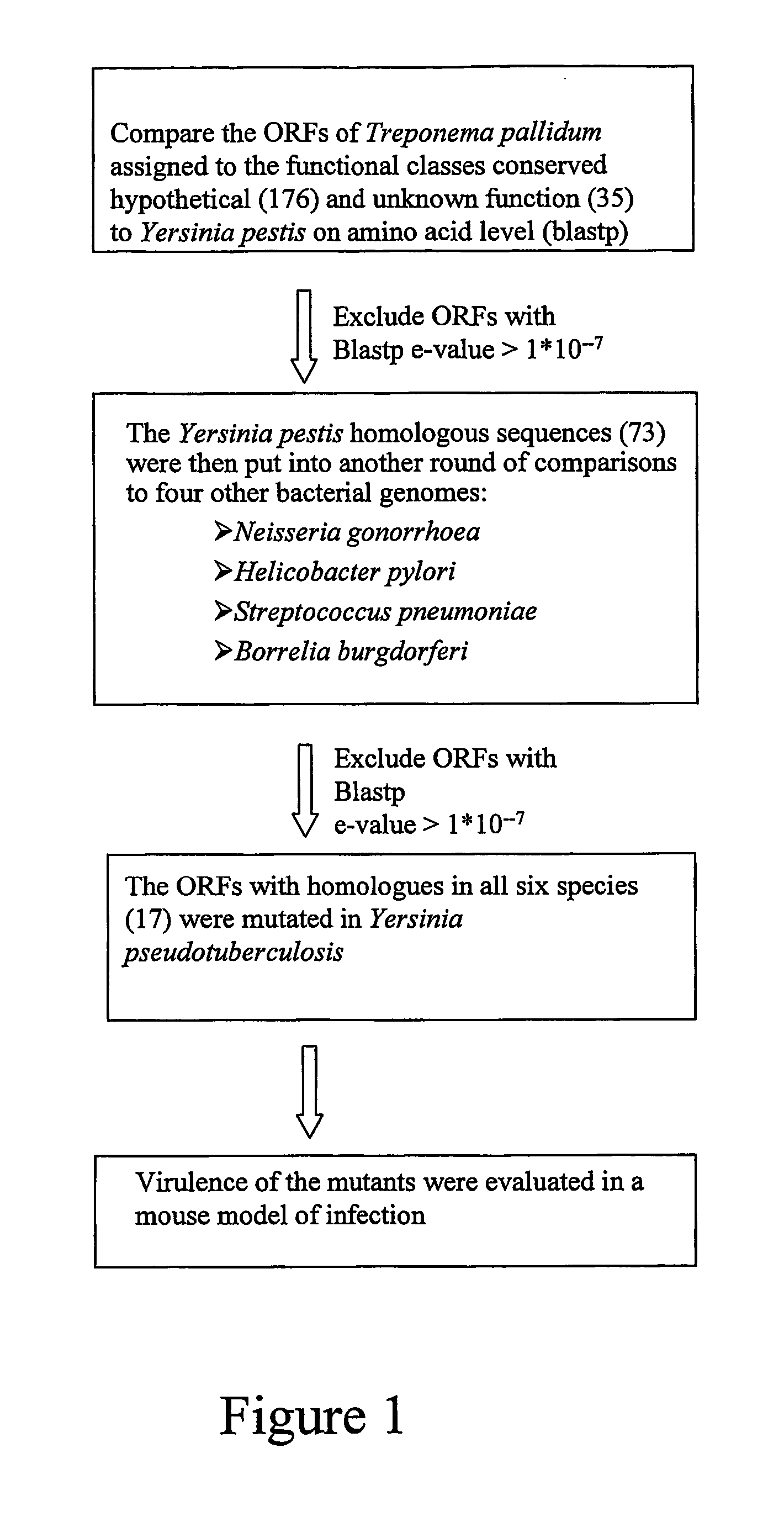Method for identification of novel virulence associated genes
a gene and gene technology, applied in the field of gene associated gene identification, can solve the problems of acute life-threatening infections, unanticipated problems, etc., and achieve the effect of physiological role of hemk
- Summary
- Abstract
- Description
- Claims
- Application Information
AI Technical Summary
Benefits of technology
Problems solved by technology
Method used
Image
Examples
example 1
[0045] Oral infections. Bacteria were grown over night in Luria Broth at 26 degrees with shaking. A 100 ml overnight culture was centrifuged and re-suspended in 50 ml of sterilized tap water. C59 black / 6 female mice were starved for water over night and challenged with the bacteria re-suspended in water at different concentrations (5×109 cfu / ml, 5×108 cfu / ml for the insertion mutants and also 5×107 cfu / ml for the deletion mutants). Each cage contained three mice and the mice were allowed to feed on 50 ml of the bacteria for 8 hours, the mice usually consumed approximately 5 ml of the bacterial suspension. In order to calculate LD50 the concentration of the bacteria fed to the mice were measured by viable count.
example 2
[0046] Identification of genes with an unknown function conserved among a selection of human pathogens giving chronic infections. To identify novel hitherto not characterised potential virulence associated genes Treponema pallidum [8, 10] were chosen for homology comparison to five other human pathogens (FIG. 1). At the time of initiating the study there were 176 conserved hypothetical genes and 35 genes with an unknown function in T. pallidum. These 211 ORFs from T. pallidum were first compared to the complete genome of Yersinia pestis, since this obligate pathogen seems to be in the process of undergoing adaptation to a new lifecycle that include the human host [11]. Y. pestis is closely related to the strain Y. pseudotuberculosis, and it has been proposed that Y. pestis is a clone that evolved from Y. pseudotuberculosis serotype O:1 for about 1,500-20,000 years ago [12]. Therefore, the well established Yersinia pseudotuberculosis animal model was chosen to evaluate whether the id...
example 3
[0048] Targeted mutations of the identified Vags and analysis of the resulting virulence phenotypes. To analyse the virulence phenotypes associated with the identified vags, mutants were created in the Y. pseudotuberculosis serotype O:1 strain IP32953. Insertion mutagenesis by a single crossover event using the silicide plasmid pNQ705 [18] were used in the first round of screening for virulence phenotypes of the identified 17 vag genes. With this strategy mutants that grow in a rich medium could be constructed for 14 of the selected vag genes. The remaining three vag genes that could not be mutated are most likely essential for growth in rich media (Tab. 1). Most of the insertion mutants had the same growth rate as the wild-type strain. One exception was the mutant vagE that apart from showing a slightly reduced growth rate also exhibited an elongated filamentous form of the bacteria, especially when incubated at 37° C. The 14 insertion mutants were analysed for their ability to exp...
PUM
| Property | Measurement | Unit |
|---|---|---|
| chemical | aaaaa | aaaaa |
| genome sizes | aaaaa | aaaaa |
| size | aaaaa | aaaaa |
Abstract
Description
Claims
Application Information
 Login to View More
Login to View More - R&D
- Intellectual Property
- Life Sciences
- Materials
- Tech Scout
- Unparalleled Data Quality
- Higher Quality Content
- 60% Fewer Hallucinations
Browse by: Latest US Patents, China's latest patents, Technical Efficacy Thesaurus, Application Domain, Technology Topic, Popular Technical Reports.
© 2025 PatSnap. All rights reserved.Legal|Privacy policy|Modern Slavery Act Transparency Statement|Sitemap|About US| Contact US: help@patsnap.com

